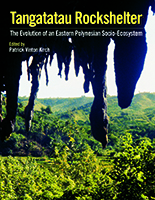Notes
Mangaia Project Master Catalog (sites M00, M35, M39, M44, M54, M63, M68, M81, M82, M83, M84, M87, M91, M92, M94, M95, M96)
Item record
Documentation
Excavation terminology
Grid Unit (or simply, unit) is the 1-m x 1-m unit of excavation and hence of horizontal control (x and y coordinates). In site MAN-44, each grid unit was labeled by the intersection of letters defining the E to W 1-m intervals along the X axis and numbers defining the S to N 1-m intervals along the Y axis.
Level: This is the vertical unit of control within a grid unit, defined by upper and lower depth boundaries (z coordinates) recorded at all four corners of the grid unit (depths were taken with a Leitz level and referenced to a single-site datum). Levels were numbered from top to bottom with Arabic numerals within each specific grid unit. These levels, however, are not arbitrarily defined slices of uniform depth. Levels did not intentionally cross stratigraphic boundaries, although sometimes thick strata were subdivided into two or more levels to provide finer vertical control. And, as is always the case when complex strata are being excavated, we did not in every instance catch indistinct or gradational transitions between deposits during the course of excavation, especially in some of the initial units when our understanding of the site’s stratigraphic sequence was still tentative. However, for the most part, one or more levels in a unit typically correspond to the beds recorded in the stratigraphic sections (see below). Our use of the term level thus approximates what some users of the Harris Matrix recording system refer to as an “excavation context” (e.g., Spence 1993). Each level was recorded separately on a preprinted level form (during the 1991 season), with beginning and ending horizontal plans drawn of in situ features; all finds recovered in situ were piece-plotted and their x, y, and z coordinates recorded. Objects recovered in the screens were referenced to the grid unit and level (e.g., D30/4, the fourth level excavated in grid unit D30). All levels in the main excavation block are correlated with the stratigraphic zones through a concordance provided here.
Feature: A feature is a subsurface, nonportable cultural artifact with three dimensions that was recognized during excavation and in most cases excavated separately (i.e., analogous to a level). Features are prefixed with F followed by a number (e.g., F31); they were numbered from 1 to 59 for the entire site. Features were integrated with a series of stratigraphic zones in a stratigraphic sequence matrix for the entire site.
Bed: This term refers to a natural sedimentary and depositional unit recognized by its lithology, structure, grain size, color, boundary contacts, and similar geoarchaeological criteria. A bed is thus a “lithostratigraphic unit” (Stein 1992:76). Beds in site MAN-44 sometimes comprised sets of very thin lenses of ash, burned organic matter, and shell midden that could be difficult to follow or separate during excavation. Beds could only be clearly defined through close examination of excavation side walls after the completion of one or more adjacent excavation units; they were numbered and described for each section in a continuous sequence of Arabic numerals from top to bottom, the number sequence being unique to the particular strati- graphic profile being recorded.
Stratigraphic Zone: A sequence of stratigraphic zones (abbreviated SZ) was defined at the completion of the 1991 excavation season. A total of 19 zones were defined, numbered from bottom to top in order of stratigraphic deposition. A stratigraphic zone may consist of a single bed as described in the stratigraphic sections or, in some cases, combines several numbered beds in sequence. Throughout this monograph, we employ the stratigraphic zones (along with features) as the main analytical units for reporting and synthesizing the site’s cultural content. In our archival databases, however, all recovered objects are referenced to a specific grid unit and level combination; a concordance links these grid unit/level proveniences to the stratigraphic zones.
Reuse
Kirch, Patrick V., 2017. Master object catalog. https://doi.org/10.25346/S6/YU2IW3
